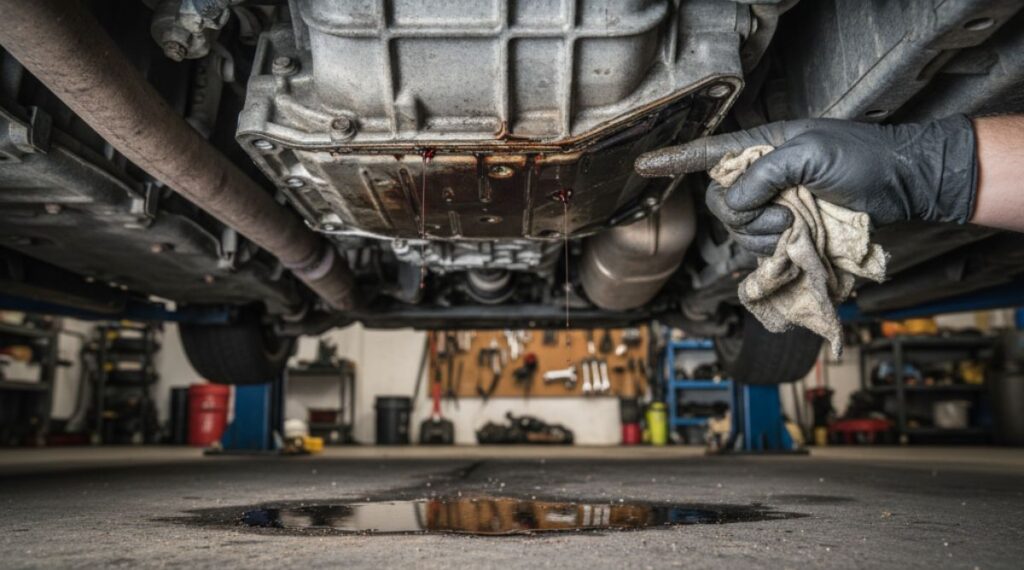Maintaining the right level of transmission fluid in your vehicle is essential for smooth gear shifting and overall performance. Many car owners overlook this aspect of maintenance, but adding transmission fluid correctly can extend the life of your transmission and prevent costly repairs. If you’ve noticed that your car’s transmission is slipping, shifting roughly, or making unusual noises, it might be time to check and refill the transmission fluid.
In this detailed guide, we’ll explain how to add transmission fluid, the tools you’ll need, step-by-step instructions, safety precautions, and how to tell when it’s time for a refill.
📘 Related Wikipedia Link: Transmission fluid – Wikipedia
Understanding What Transmission Fluid Does
Before learning how to add transmission fluid, it’s important to understand what it actually does. Transmission fluid is a special lubricant used in both manual and automatic transmissions. It keeps all the moving parts within the transmission cool and well-lubricated, helps transmit power from the engine to the wheels, and ensures smooth gear shifting.
In automatic transmissions, the fluid also functions as a hydraulic medium that controls the transmission system. Without enough fluid, friction increases, leading to overheating, metal wear, and ultimately, transmission failure.
Signs That Your Vehicle Needs Transmission Fluid

Here are some clear indicators that your vehicle might need more transmission fluid:
- Slipping Gears – If your car suddenly changes gears without reason, low transmission fluid could be the cause.
- Delayed or Rough Shifting – A lag when shifting gears, or a noticeable jolt, usually means the fluid is low or dirty.
- Unusual Noises – Whining or grinding noises when accelerating often signal low or degraded transmission fluid.
- Transmission Overheating – Overheating happens when fluid levels are too low to properly lubricate the gears.
- Visible Leaks – Red or brown stains under your vehicle often indicate a transmission fluid leak.
- Check Engine Light – Modern cars can detect transmission issues, so a lit engine light might point toward a fluid problem.
If you notice any of these signs, it’s time to check and possibly add more fluid.
Tools and Materials You’ll Need
To safely and effectively add transmission fluid, you’ll need the following:
- Transmission fluid (refer to your vehicle’s owner manual for the correct type)
- Clean funnel
- Rag or paper towels
- Gloves (to protect your hands from hot or dirty components)
- Dipstick (usually built into your vehicle)
- Jack and jack stands (if you need access from underneath)
Optional: a flashlight for better visibility under the hood or car.
How to Check the Transmission Fluid Level

Before adding new fluid, always check the current level. Here’s how to do it:
Step 1: Park Safely and Warm Up the Engine
Park your car on a flat surface and engage the parking brake. Start the engine and let it warm up for about 5–10 minutes. Transmission fluid expands when warm, so checking it at operating temperature gives an accurate reading.
Step 2: Locate the Transmission Dipstick
Open the hood and look for the transmission dipstick. It’s often near the back of the engine bay. It usually has a colored handle (often red or yellow) labeled “Transmission” or “ATF.”
Step 3: Pull Out and Wipe the Dipstick
Remove the dipstick, wipe it clean with a rag or paper towel, then reinsert it fully into the tube.
Step 4: Check the Fluid Level
Pull the dipstick out again and observe the fluid level. It should be between the “MIN” and “MAX” marks. If it’s below the minimum line, you’ll need to add more fluid.
Step 5: Check Fluid Color and Condition
Healthy transmission fluid is usually bright red or pink. If it appears dark brown or smells burnt, you might need a complete fluid change, not just a top-up.
How to Add Transmission Fluid (Step-by-Step)

Once you’ve confirmed that the level is low, follow these steps to add transmission fluid safely:
Step 1: Use the Correct Type of Fluid
Consult your car’s owner manual to identify the exact transmission fluid your vehicle requires. Using the wrong type can lead to severe damage.
Step 2: Position the Funnel
Insert the clean funnel into the dipstick tube. This tube leads directly to the transmission reservoir.
Step 3: Add Fluid Gradually
Pour the fluid slowly through the funnel. Start by adding half a quart at a time to avoid overfilling.
Step 4: Recheck the Level
After adding some fluid, reinsert the dipstick, wait a few seconds, and check the level again. Continue adding small amounts until the dipstick reading shows the fluid level between “MIN” and “MAX.”
Step 5: Run the Engine and Shift Gears
With the car idling, move the gear selector through all gears (P, R, N, D, etc.) and then back to “Park.” This helps the fluid circulate through the entire system.
Step 6: Recheck and Secure Everything
Finally, recheck the level one last time. If everything is fine, securely replace the dipstick and close the hood. Dispose of any used rags properly.
How Often Should You Add or Change Transmission Fluid?

Most manufacturers recommend checking the transmission fluid every 30,000 to 60,000 miles, though modern vehicles with sealed systems might have longer intervals.
Adding fluid is different from changing it. If your fluid is low due to a leak, simply topping it up won’t fix the issue — you’ll need to find and repair the source of the leak.
For older vehicles or those used in harsh driving conditions (like towing or frequent stop-and-go traffic), more frequent checks are advisable.
Common Mistakes to Avoid When Adding Transmission Fluid
- Using the Wrong Fluid Type – Always use the manufacturer-recommended fluid; otherwise, it can damage seals and clutches.
- Overfilling – Too much fluid can cause pressure buildup, foaming, and erratic shifting.
- Adding Fluid to the Wrong Tube – Never confuse the engine oil dipstick with the transmission one.
- Skipping Warm-Up – Checking cold fluid can result in inaccurate readings.
- Ignoring Dirty Fluid – If the fluid looks burnt or black, changing it entirely is the better option.
What to Do If Transmission Fluid Is Leaking
A leak can cause transmission failure if not fixed promptly. Common leak sources include:
- Loose drain plugs or pan bolts
- Damaged transmission pan gasket
- Worn seals or lines
If you suspect a leak, place a piece of cardboard under your car overnight. Red or brown spots are a sure sign of fluid loss. Visit a certified mechanic immediately if you find a leak.
The Role of Transmission Fluid in Vehicle Health

Transmission fluid is as important as engine oil for your vehicle’s health. It lubricates internal components, prevents overheating, and enables smooth gear transitions. Keeping it at the correct level ensures:
- Longer transmission life
- Better fuel efficiency
- Reduced wear and tear
- Smooth and silent gear shifting
A simple habit of checking your fluid monthly can prevent thousands of dollars in transmission repairs.
When to Visit a Mechanic
While adding fluid is easy, there are cases where professional help is essential:
- The car doesn’t move even after adding fluid
- You hear grinding or clunking sounds
- The fluid turns black quickly after replacement
- You suspect a major leak
Mechanics can perform a transmission flush, replace filters, and fix internal problems that DIY maintenance cannot address.
Final Tips for Vehicle Owners
- Check fluid monthly – especially before long trips.
- Use a clean funnel – to avoid contamination.
- Keep spare fluid – in your garage or trunk for emergencies.
- Don’t delay repairs – minor leaks can quickly become major issues.
- Record fluid checks – keeping a maintenance log helps track vehicle health.
Conclusion
Knowing how to add transmission fluid is an essential part of car maintenance that every driver should understand. It’s not a complex process, but it requires care and precision. Ensuring the correct fluid type, amount, and cleanliness keeps your transmission running smoothly and extends your car’s life.
So, the next time your car hesitates to shift or makes unusual noises, check your transmission fluid first. A few minutes of maintenance could save you from thousands in repair bills.
Related Wikipedia Link: Transmission fluid – Wikipedia










